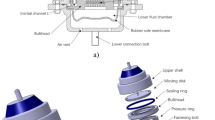Abstract
Isolation mounts using magneto-rheological (MR) fluid have increasing potential for various applications. This paper introduces new design and manufacturing aspects of MR engine mounts. CAD software was used to design MR mounts and three different types of MR mount prototypes were considered. Later, magnetostatic analyses were performed to validate the designed configuration of the electromagnetic coil, which controlled the MR fluid flow. The MR mounts were manufactured and, then, tested statically and dynamically using a servo-hydraulic rate machine. Static tests were performed with amplitudes between 0–10 mm. Dynamic tests were performed under excitation frequencies in between 0–100 Hz with amplitudes of ±0.1 mm, ±0.5 mm, ±1.0 mm and ±2.0 mm as well as under excitation frequencies in between 0–20 Hz with amplitudes of ±3.0 mm, ±4.0 mm. Besides the MR mounts, hydro mount and elastomeric top were tested adopting the same procedure. The finding of different mount properties was explained and MR mount characteristics in frequency domain were demonstrated. In addition, the measured characteristics were compared with each other for hydraulic mount and elastomeric top.
Similar content being viewed by others
References
M. N. Khajavi and V. Abdollahi, Comparison between optimized passive vehicle suspension system and semi active fuzzy logic controlled suspension system regarding ride and handling, World Academy of Science, Engineering and Technology, 1 (2007) 57–61.
http://www.materiatech–carma.net/html/pdf/actesmiec08/Albert_ACHEN–LORD–Magnetorheo.pdf, Accessed 19 April (2014).
J. R. Lloyd, M. O. Hayesmichel and C. J. Radcliffe, Internal organizational measurement for control of magnetorheological fluid properties, Journal of Fluids Engineering, 129 (423) (2007).
J. Rabinow, The magnetic fluid clutch, AIEE Transactions, 67 (1948) 1308–1315.
Y. K. Ahn, B. Yang, M. Ahmadian and S. Morishita, A small–sized variable–damping mount using magnetorheological fluid, Journal of Intelligent Material Systems and Structures, 16 (2) (2005) 127–133.
H. S. Lee and S. B. Choi, Control and response characteristics of a magnetorheological fluid damper for passenger vehicles, Journal of Intelligent Material Systems and Structures, 11 (1) (2000) 80–87.
H. Janocha and D. J. Jendritza, Adaptronics and smart structures: Basics, materials, design, and applications, Springer (1997) 198–200.
S. B. Choi, M. H. Nam and B. K. Lee, Vibration control of MR seat damper for commercial vehicles, Journal of Intelligent Materials System and Structures, 11 (12) (2000) 936–944.
S. J. McManus, K. A. St. Clair, P. E. Boileau and J. Boutin, Evaluation of vibration and shock attenuation performance of a suspension seat with a semi–active magnetorheological fluid damper, Journal of Sound and Vibration, 253 (1) (2002) 313–327.
Y. F. Duan, Y. Q. Ni and J. M. Ko, Cable vibration control using magnetorheological dampers, Journal of Intelligent Material Systems and Structures, 17 (2006) 321.
J. D. Carlson, W. Matthis and J. E. Toscano, Smart prosthetics based on magnetorheological fluids, Proceedings of SPIE, 4332 (2001) 308–316.
M. T. Avraam, MR–fluid brake design and its application to a portable muscular rehabilitation device, Ph.D. Thesis, Universite libre de Bruxelles, Department of Mechanical Engineering and Robotics, Belgium, 7–8 (13) (2009) 19–20.
http://delphi.com/pdf/news/DelphiMagnetoRheologicalEngine Mounts070909.pdf, Accessed 19 April (2014).
S. Cesmeci and T. Engin, Modeling and testing of a fieldcontrollable magnetorheological fluid damper, International Journal of Mechanical Sciences, 52 (2010) 1036–1046.
M. Elahinia, C. Ciocanel, T. M. Nguyen and S. Wang, MRand ER–based semiactive engine mounts: A review, Smart Materials Research, Article ID 831017, 2013 (2013) 21.
S. R. Hong, S. B. Choi and M. S. Han, Vibration control of a frame structure using electro–rheological fluid mounts, International Journal of Mechanical Sciences, 44 (2002) 2027–2045.
S. B. Choi, S. R. Hong, K. G. Sung and J. W. Sohn, Optimal control of structural vibrations using a mixed–mode magnetorheological fluid mount, International Journal of Mechanical Sciences, 50 (2008) 559–568.
T. Feyzi, R. Tikani, M. Esfahanian and R. S. Ziaei, Performance analysis of different modified MR engines mounts, Journal of Solid Mechanics, 3 (2) (2011) 124–131.
Y. Yu, N. G. Naganathan and R. V. Dukkipati, A literature review of automotive vehicle engine mounting systems, Mechanism and Machine Theory, 36 (2001) 123–142.
Q. H. Nguyen, S. B. Choi, Y. S. Lee and M. S. Han, Optimal design of high damping force engine mount featuring MR valve structure with both annular and radial flow paths, Smart Mater. Struct., 22 (2013) 115024.
I. Korkmaz, Araçlarda motor askı sistemlerinin incelenmesi, M.Sc. Thesis, Istanbul Technical University Graduate School of Science Engineering and Technology, Istanbul (2007) 1–7, 18–26, 34–37.
T. M. Nguyen, A novel semi–active magnetorheological mount for vibration isolation, Ph.D. Thesis, The University of Toledo, USA (2009) 1–10, 43–51, 91–92, 101.
Author information
Authors and Affiliations
Corresponding author
Additional information
Recommended by Associate Editor Hyeong-Joon Ahn
Tamer Türkücü is a Ph.D. student in industrial design engineering, Gazi University, Ankara, Turkey. He graduated with a bachelor's degree in mechanical engineering from Selcuk University in 2004. He received a master’s degree in mechanical engineering from Gazi University in 2013.
Rights and permissions
About this article
Cite this article
Türkücü, T., Keleş, Ö. Magneto-rheological engine mount design and experimental characterization. J Mech Sci Technol 32, 5171–5178 (2018). https://doi.org/10.1007/s12206-018-1015-y
Received:
Revised:
Accepted:
Published:
Issue Date:
DOI: https://doi.org/10.1007/s12206-018-1015-y




